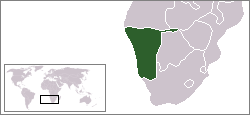South West African Police
| South West African Police Suidwes-Afrikaanse Polisie Südwestafrikanische Polizei | |
|---|---|
| Abbreviation | SWAPOL |
| Agency overview | |
| Formed | 1920 |
| Dissolved | 1990 |
| Superseding agency | Namibian Police Force |
| Jurisdictional structure | |
| National agency | South West Africa |
| Operations jurisdiction | South West Africa |
 | |
| Map of South West African Police's jurisdiction. | |
| Size | 825,615 km² |
| General nature | • Local civilian agency |
|
| |
The South West African Police, often abbreviated to SWAPOL, was the national police force of South West Africa (Namibia). It was responsible for law enforcement in South West Africa when that territory was being governed by South Africa as a League of Nations mandate, and was organised and structured both as a paramilitary force and as a civil police force.
History
SWAPOL was established following World War I, when the South African government assumed administration of South West Africa under the terms of a League of Nations mandate. Between 1915 and 1919, public security and law enforcement were entrusted to the South African military police. On December 31, 1939, the rule of law returned to South West Africa when SWAPOL was founded as the territory's first civil police agency. An investigation department was established in 1920. SWAPOL was disbanded in 1939.
The South African Police were responsible for the territory from 1939 to 1981. SWAPOL was re-established in 1981, after the territory had become self-governing.
Koevoet
SWAPOL's most controversial unit was its counter-insurgency division, which was known officially as SWAPOL-COIN or Operation K, but more commonly referred to as Koevoet.[1] Koevoet was initially an autonomous unit under the nominal authority of the SAP Security Branch, but became part of SWAPOL in 1985.[2] Koevoet worked closely with SWAPOL's own Security Branch in investigating crimes of a political nature, namely politically motivated murders.[3] The unit was better known for its combat operations against insurgents of the People's Liberation Army of Namibia (PLAN) in Ovamboland, which earned it a formidable reputation.[4] Koevoet's hybrid status as a paramilitary police unit made it something of a legal anomaly; for example, it lacked the mandate to hold insurgents as prisoners of war.[3] Insurgents were technically supposed to be apprehended for trial in open courts as common law criminals.[3] Based on this interpretation, the South West African courts ruled that insurgents captured by Koevoet had to be granted legal representation and could not be detained indefinitely.[3]
With the South African Border War drawing to a close in mid-1989, Koevoet was greatly reduced in size and most of its personnel were reassigned to other divisions by SWAPOL.[5] Nevertheless, the unit's continued existence was the subject of much controversy, as both current and former Koevoet operators were accused of political intimidation and human rights abuses.[6] United Nations Security Council Resolution 640 explicitly named Koevoet as being a barrier to the peace process in Namibia and demanded its disbandment.[7] SWAPOL dissolved the unit on October 30, 1989.[8]
References
- ↑ Stiff, Peter (2004). The Covert War: Koevoet Operations in Namibia, 1979-1989. Alberton: Galago Publishing Pty Ltd. pp. 53, 121. ISBN 978-1919854038.
- ↑ Nowrojee, Binaifer (1993). Divide and Rule: State-sponsored Ethnic Violence in Kenya. New York: Human Rights Watch. pp. 17–26. ISBN 978-1564321176.
- 1 2 3 4 Herbstein, Denis; Evenson, John (1989). The Devils Are Among Us: The War for Namibia. London: Zed Books Ltd. pp. 28, 61–92. ISBN 978-0862328962.
- ↑ Harmse, Kyle; Dunstan, Simon (23 February 2017). South African Armour of the Border War 1975–89. Oxford: Osprey Publishing. pp. 22–26. ISBN 978-1472817433.
- ↑ McMullin, Jaremey (2013). Ex-Combatants and the Post-Conflict State: Challenges of Reintegration. Basingstoke: Palgrave-Macmillan. pp. 81–89. ISBN 978-1-349-33179-6.
- ↑ Krasno, Jean; Hayes, Bradd; Daniel, Donald (2003). Leveraging for Success in United Nations Peace Operations. Westport, Connecticut: Praeger. pp. 35–47. ISBN 978-0275978839.
- ↑ Colletta, Nat; Kostner, Markus; Wiederhofer, Indo (1996). Case Studies of War-To-Peace Transition: The Demobilization and Reintegration of Ex-Combatants in Ethiopia, Namibia, and Uganda. Washington DC: World Bank. pp. 127–142. ISBN 978-0821336748.
- ↑ Wren, Christopher S. (31 October 1989). "South Africa Disbands Special Police in Namibia". New York Times. Retrieved 2007-10-24.